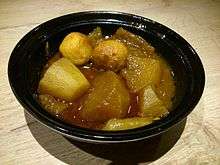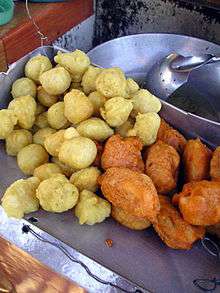Fish ball
| Fish ball | |||||||||||||||
|
Fish ball closeup | |||||||||||||||
| Traditional Chinese | 魚蛋 or 魚旦 | ||||||||||||||
|---|---|---|---|---|---|---|---|---|---|---|---|---|---|---|---|
| Simplified Chinese | 鱼蛋 or 鱼旦 | ||||||||||||||
| Literal meaning | fish egg | ||||||||||||||
| |||||||||||||||
| Alternative Chinese name | |||||||||||||||
| Traditional Chinese | 魚丸 | ||||||||||||||
| Simplified Chinese | 鱼丸 | ||||||||||||||
| Literal meaning | fish ball | ||||||||||||||
| |||||||||||||||
Fish balls are a common food in southern China, Hong Kong, Macau, Southeast Asia and overseas Chinese communities made from "fish paste" (otherwise known as Chinese: 魚漿; pinyin: yújiāng; Jyutping: jyu4 zoeng1). They are also common in Scandinavia, where they are usually made from cod or haddock.
Production
There are two variants of fish balls, each differing in their textures, production method, and primary regions of production:
- For East Asian fishballs, the fish are either shredded, coarsely ground, or even pounded. The fish then undergoes prolonged mixing with added salt until a smooth texture is attained. This technique, similar to the process of making surimi, uncoils and stretches previously wound and tangled protein strands in the fish, which produces a food with firm "bouncy" textures.
- Scandinavian fish balls are made of completely pureed fish, milk and potato flour (or potato starch), and shaped without additional processing, which produces a softer textured food.
Regional variations



Faroe Islands
In the Faroe Islands, fish balls are called knettir and are made with ground fish and mutton fat.
Fuzhou
In the Fuzhou area, "Fuzhou fish balls" (福州鱼丸) are made from fish with a minced pork filling.
Taiwan
Milkfish Ball (虱目魚丸) is frequently found in Taiwan. The natural texture and aroma of the Milkfish give this variant a unique taste. This is one of the main ways Milkfishes' lesser-prized yet highly abundant white meat is consumed.
Yellow (street food)
Smaller in size, made from cheaper fish than the white variety, they are usually sold at food stalls with five to seven balls on a bamboo skewer. The fish balls are usually boiled in a spicy curry sauce. Virtually every street stall creates its own recipe of curry satay sauce to differentiate them from other sellers. Fish balls are one of the city's most popular and representative "street foods" (街頭熟食).[1]
White (restaurant)
White fish balls are larger in size and made with only fish, no other ingredients are added, and then boiled till done. As a result of this cooking method, these fish balls are white in color. White fish balls should have an elastic (bouncy) and fluffy texture and a strong taste of fish. They are made using a more costly fish, and has a considerably different texture and taste. This kind is usually served to complement noodles at Chiuchow-style noodle restaurants,[2] and at some cha chaan tengs, which also sell beef balls (牛丸) and cuttlefish balls (墨魚丸). Readily available in traditional markets and supermarkets, fish balls are also a popular ingredient for hot pot.
White fish balls from traditional fish ball restaurants are made from fresh fish and are normally hand-made (手打) by the owners using traditional techniques.
Golden
The big golden fish ball is a snack in Cheung Chau. Distinguishing features include size, sauce and texture. They can be fist-sized and are served with a special curry sauce, and are mainly made from fresh fish which makes the texture more smooth.
Ingredients
The basic ingredients are fish, flour and flavourings such as salt and sugar, can also be used. The proportions depend on the quality and type to be made. The white fish balls found in some traditional Hong Kong restaurants are made using fresh fish; while street style are made using cheap fish and a mixture of flour to reduce costs.[3] Flathead mullet (九棍魚/烏仔魚) and Daggertooth pike conger (門鱔) are common choices.
Originally, to reduce costs, they were likely made by mixing and frying the remaining materials of Chouzhou fish ball (潮州白魚丸) or stale fish. More recently, they began to be imported and nowadays, they are mainly imported by wholesalers and the texture is more consistent.[4]
Indonesia
In Indonesia, fish balls are called bakso ikan (fish bakso). The most popular bakso are made of beef, but fish bakso is also available, served with tofu and fish otak-otak in clear broth soup as tahu kok, or thinly sliced as additional ingredients in mie goreng, kwetiau goreng, and cap cai. A similar dish made of fish is called pempek.
Peninsular Malaysia and Singapore
Fish balls, known as 鱼圆 (yú yuán) or 魚丸 (yú wán), are cooked in many ways in Peninsular Malaysia and Singapore. They can be served with soup and noodles like the Chiuchow style or with yong tau foo. They can also be served with noodles called mee pok.
Philippines
Fish balls are a popular street food in the Philippines, and considered a cultural delicacy. The most common type of Filipino fish balls are known as bola-bola (literally, "ball-ball"). They are somewhat flat in shape, most often made from cuttlefish or pollock, and served with a sweet and spicy sauce or with a thick, black, sweet and sour sauce.
Fish balls in the Philippines are sold by street vendors pushing wooden deep-frying carts. The balls are served skewered, offered with three kinds of dipping sauces: spicy (white/orange coloured) – vinegar, water, diced onions and garlic; sweet (brown gravy coloured) – corn starch, banana ketchup, sugar and salt; and sweet/sour (amber or deeper orange coloured) – the sweet variety with lots of small hot chilis added. Dark sauces are rare, as these are soy sauce-based and soy sauce is expensive for street food.
A recent trend in the industry is the introduction of varieties: chicken, squid (cuttlefish actually), and kikiam. The last are low cost renditions vaguely resembling the original Chinese delicacy of the same name.
Scandinavia

Fiskbullar in Sweden and fiskeboller in Norway are usually bought in cans. In Sweden, they are normally served with mashed potatoes or rice, boiled green peas and dill, caviar or seafood sauces. In Norway, they are commonly served with potatoes and white sauce made with the stock from the can, sometimes with added curry, and occasionally boiled carrot slices are served on the side or added into the sauce along with the fish balls.
Thailand
Fish balls are very popular in Thai cuisine. They are usually fried or grilled as a snack. In Chinese-influenced restaurants, fish balls are cooked in noodle soups and come in many varieties. They can also be eaten in a Thai curry. Kaeng khiao wan luk chin pla is green curry with fish balls. One of the main fishes used in the production of fish balls in Thailand is Pla krai (Chitala ornata).
See also
References
- ↑ "Curry fish balls & Temple Street, Hong Kong". yeinjee.com. 21 October 2007. Retrieved 12 August 2012.
- ↑ Man, Joyce "Aberdeen's best fish ball shop to close" CNN Go. 24 February 2012. Retrieved 4 March 2012
- ↑ "Traditional Fish Balls (Hardship in Fish Supplies)". Retrieved 18 December 2012.
- ↑ 《50經典小吃》刊於2003/01/10《飲食男女》
External links
| Wikimedia Commons has media related to Fish ball. |


